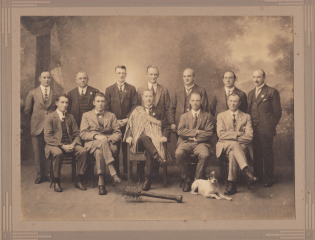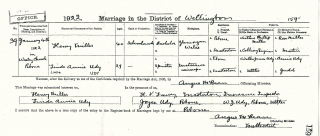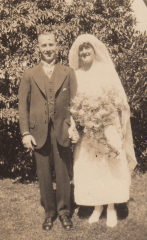David’s paternal grandmother, Linda, was descended from the Udy family in New Zealand. It was a well respected family, one of the original settler families from Cornwall, England and had been fully researched.
However, very little was known about David’s paternal grandfather, Henry Miller. He was a teacher, originally from Britain but had moved to South Africa ‘for the sake of his health’. It was neither known when he had arrived in New Zealand nor where he had met and married Linda Udy.
They had one son, Joseph, known as Joe. When Joe met his future wife Kim, he told her that his father had been Jewish and so David grew up knowing that he had Jewish heritage.
Henry became very well respected in the local community, becoming a Master Mason and subsequently Past Master of Eastbourne Lodge No 217, NZ and was involved with the Masterton Savage Club which provides entertainment for the local community whilst raising money for local amenities1. The photo shows him as Chief Savage.
The Udy family tree noted Henry’s birth as 15 December 1881 but there were no details of his family. Indeed, nobody knew anything of his family in Britain.
A genealogist from New Zealand was to speak at the ‘Who Do you Think You Are?’ annual event in London in February 2011 and I took myself there for the day. I noted useful tips regarding New Zealand genealogy and returned home to order a copy of the marriage record of Linda Udy and Henry Miller.
My attempts to keep it secret were somewhat blown apart by my forgetting about the order and so, when the envelope landed on my front door mat a few weeks later, I picked it up, exclaimed at the post mark and uttered aloud the words “I wonder who is writing to me from New Zealand?”
No sooner did I say the words than I realised what it was but it was too late. David was there and he’d heard them. I had to confess my intentions. He was not surprised and said that he’d long since worked out what I was doing. Evidently I am no good at subterfuge or working under cover!
Family history research requires a methodical approach. The tools which we use to research English and Welsh family history are the civil registration birth, marriage and death records from 1837, and the censuses from 1841 to 1911. Prior to 1837 we are dependent on nearly three hundred years of parish registers, which are variable in their quality and even their survival rates.
Birth certificates give the name of the parents, including the mother’s maiden name, the father’s occupation, the address where the baby was born and the name of the person who registered the birth.
Marriage certificates record the names of the bride and groom, their ages and occupations, their home addresses and their father’s name and occupation. The names of witnesses are also given. As they were often family members, they can help identify the bride and/or groom.
Death certificates record the name of the deceased, their age and where they died, their occupation and cause of death. They also have the name and address of the person informing the registrar of the death, which is often useful.
The censuses show family groups living at a particular address on a given night every ten years since 1841. Details include the names, ages, relationship to the head of the household, occupations and places of birth. The details of any visitors staying there at the time are also given.
In the UK there is a 100 year moratorium on publishing details of censuses for reasons of privacy and so the most recent one to which we have access is the 1911 census.
When ordering the marriage certificate for Linda and Henry, I was delighted to find that the New Zealand marriage records contain much more information than English and Welsh ones.
Henry Miller and Linda Annie Udy were married in the District of Wellington, New Zealand on 4th January 1922.
Linda was aged 29, a spinster. She was born in Matarawa in the Wairarapa district. Her father was Waller James Udy, a settler. Her mother was Annie Udy, maiden name Judd.
Henry was aged 40, a schoolmaster and a bachelor. He was born in Glamorgan, a county in Wales. His father was Arthur Phillip Miller, a colliery engineer. His mother was Rose Miller, maiden name Martin.
At the time of the wedding they were both resident at Petone though their usual residence was Masterton.
The age of 40 at the time of his marriage indicates that Henry was born in 1881.
Henry progressed through his teaching career and by the time he died he was headmaster of Hutt school.
Henry Miller died on 6 January 1946 leaving Linda and their son Joseph.
So, not only did I have Henry’s father’s name and occupation but also his mother’s name and maiden name and the place where Henry was born. How marvellous! How I wish English marriage certificates had the same information. With such a wealth of detail I knew it was going to be easy to find Henry and his family in Wales. Eagerly I reached for my keyboard and began searching the records on Findmypast, beginning with the censuses in Glamorgan.
The 1881 census was taken on 3rd April so he would not be listed but, with luck, his parents might have been married by then and/or living together, and would be listed, plus any older siblings of Henry. If not, Henry and his parents would most probably be on the 1891 census.
I could not find him or his parents on any census from 1881 to 1911, in Wales or in England.
I looked at all the 1891 census entries which had a Henry Miller of the right age and who had been born in Glamorgan and carefully checked the names of the parents and the father’s occupation. Nothing matched.
I turned to the birth records index which lists date of registration of the event rather than the actual birth, in annual quarterly periods rather than in months. Unfortunately, the mother’s maiden name isn’t shown on the index entry until 1911, so it can be a laborious task of finding a suitable entry and expensive to then order a copy of the birth certificate to see if it is the right one.
As Henry was born on 15th December 1881, I looked for Henry Miller births registered in the last quarter of 1881 or the first quarter of 1882. There were none in Glamorgan.
This was a nuisance but I’ve often found that people born in that era were not entirely sure of their date of birth or their age, so I widened my search. I found two births earlier in 1881 and one in 1882 and ordered the certificates. None of the details applied to ‘our’ Henry.
I wondered if Henry had been born illegitimate so I ordered a certificate for a Henry Martin born in December 1882 but, although the date given was 15th December, the parents were married, and none of the details applied to ‘our’ Henry.
I had run out of Henry Miller births in Glamorgan around the time which would make Henry Miller 40, or a year or two younger or older at the time of his marriage on 4 January 1922.
So I started looking for his father and checked the indexes for a birth, marriage or death entry in England or Wales. And I checked the censuses. I found nothing. Arthur Phillip Miller did not exist in England or Wales.
I know that when people grew up with their mother, having lost their father at an early age, they may know her name but not his name. Faced with the question at the Registrar’s office, they make up a name for the marriage certificate. So, with that possibility in mind, I also searched the censuses for a Rose Miller and a son Henry. Not a sign of them. I wondered if he had been born illegitimate and as Henry had given his mother’s maiden name, I searched for Rose Martin and a son Henry. Again, there was nothing.
I wondered whether Henry had been born elsewhere but had moved to Glamorgan as an infant and, having spent his childhood there, assumed that was where he was born. So I cast my net wider, looking for a ten – twelve year old Henry Miller in the 1891 census in Glamorgan who had been born elsewhere. There was one likely candidate and I sent for another birth certificate. It was not ‘our’ Henry.
I checked out every Rose Miller or Martin on the 1881 and 1891 censuses. I also looked at Rosanna Martin and Rosina Martin, both of whom had married in 1874, one in Pontypridd, one in Cardiff. Rosanna looked promising for a while but the trail petered out and finally I concluded that nothing regarding a Rose, Rosina or Rosanna Martin or Miller seemed to tally with what we thought we knew.
I wondered if Henry who, according to the marriage certificate was eleven years older than Linda, had been economical with the truth with regard to his age, to make him more socially acceptable. So I looked for a Henry born earlier than 1881 but the closest would have made him noticeably several years older than he said he was. And none of the family details matched up.
Bearing in mind his Jewish ancestry I wondered whether Henry had anglicised his surname and his father’s name. And whether they had actually come from Europe or Russia to south Wales.
I discovered that there had been a lot of Jewish emigration to south Wales in the 1800s and there was quite a large Jewish population in the area at the time Henry was born but felt that I had very little with which to consult the available resources.
I was sure that, to name his father’s occupation as a colliery engineer, Henry must have known something of collieries, knowledge gained in a mining area, whether in the valleys of Glamorgan in south Wales or elsewhere.
The problem with relying on censuses to pinpoint people is that the census is only taken every ten years. Somebody could move into the area just after one census and move on just before another census. They could be there nearly ten years and learn a significant amount about the area and life there but not show up on a census for the area.
I chased up hill and down dale, formulating theories and checking them out, becoming desperate to find Henry but with no useful results. Some looked promising but it was all circumstantial evidence. Good family history research needs facts and I had none. It was evident that Henry’s details on his marriage certificate were not to be trusted. Finally, I felt that I had exhausted all avenues to find Henry’s birth record and his family.
There are times when the family historian has to accept that, for a variety of reasons, perhaps the person didn’t want to be identified and that they covered their tracks very carefully.
Silently I began to accuse Henry of nefarious activities, including stolen identity and to wonder just why he had gone to South Africa ‘for the sake of his health’. These days that phrase can have an ambiguous meaning.
On 15 December 2012 I admitted defeat and sent a full 12 page account of my attempts to find Henry to Kim in NZ and to David.
The question remained: Who was Henry?
One of the problems in tracing Henry was that we didn’t know how long Henry had been in New Zealand, nor when he had left the UK (assuming that it actually was the UK he’d left behind) to go to South Africa.
Unfortunately there is no census information available in New Zealand as, once the government had extracted the statistical and other information in which they were interested, the censuses were destroyed. Various records are available and are used as substitutes, including the electoral rolls but none give the details of all the members of a household at a given time in the way that the census does.
I had looked at the later electoral rolls but Kim’s husband, Ken, researched the earlier ones. There is no mention of Henry in the 1905/6 electoral roll. The earliest mention of him is in 1911 and he re-appears in the 1914 and 1919 ones. From 1928 he is shown with his wife Linda.
So we can be reasonably certain that Henry arrived in New Zealand some time between 1905 and 1911.
Kim is a busy Professor in a university in New Zealand. As it was rapidly approaching the Christmas holidays, when the university is closed, she decided it was time to investigate the family archives. These consist of papers and artefacts, belonging to Joe or Henry, which she had been keeping until such time as David became interested in the contents. She had not read the papers and had no idea what was there.
On 22nd December I received an email which said that Kim had started searching the archive cupboard and had found Henry’s obituary and a partial family tree. It concluded with the following cryptic remark: “Can you access birth records from Russia?” I was speechless!
Ken and their visitor were left to deal with the pre Christmas household chores, shopping and cooking whilst Kim concentrated on the task in hand.
A day later came an email saying “Am still searching the cupboard but am nearly finished. Hoping to piece the astonishing story together and send it soon. Just don’t believe any details you now have, except that he was born in 1881″.
To say that David and I were intrigued and found the emails distinctly tantalising is a considerable understatement.
Included in the archives were a newspaper obituary, a rough family tree, letters from Henry’s siblings, a birth certificate and testimonials. The papers took a great deal of sorting before Kim could write up an account of what she’d found. Along the way, she formulated several different hypotheses, only to have them overturned by other emerging details.
Kim finished her account and emailed it to us early on 24th December. It was both the most amazing Christmas present which anyone could receive and the most disruptive. There was no other topic of conversation over Christmas and even the planned dinner was postponed in favour of simple roast chicken as we were too busy assimilating the details to concentrate on an unfamiliar recipe.
Next: The Mysterious Henry Miller
1 The original Savage club was formed in 1856 in London by a group of actors, musicians, literary and art people. They named it after a little known poet and dramatist, Richard Savage, who lived 100 years before. Within 30 years clubs had been formed in other countries, including New Zealand. Originally they provided entertainment amongst themselves, such as variety shows, concerts and plays but then expanded to provide entertainment for the local community whilst raising money for local amenities. http://www.kindredclubsnz.com/229659012


